
94% of researchers rate our articles as excellent or good
Learn more about the work of our research integrity team to safeguard the quality of each article we publish.
Find out more
ORIGINAL RESEARCH article
Front. Phys. , 09 September 2022
Sec. Optics and Photonics
Volume 10 - 2022 | https://doi.org/10.3389/fphy.2022.989047
This article is part of the Research Topic Advances in Optical Frequency Comb Sources, Technology, and Applications View all 9 articles
Microcombs—generated by coherently pumping nonlinear microresonators—have emerged as a state-of-the-art scheme at the chip scale. Dual-comb spectroscopy (DCS) technology further takes advantage of the miniature system, and has been demonstrated as a powerful tool for real-time and broadband optical sampling of molecular spectra. Here, a novel soliton dual-microcomb generation method by rapid frequency sweep and sideband thermal compensation is put forward, and dual-microcomb optical spectra range beyond 200-nm has been successfully demonstrated in two microresonators with moderate quality factors. Compared to the dual-microcomb with a weak thermal compensation effect, the demonstrated dual-microcomb shows much lower-noise RF beat notes (<10 kHz) and smaller Allan deviations (1.0 × 10–4 at 1 ms) by increasing sideband power. Moreover, the dual-microcomb has been utilized in the gas absorption detection of H12CN for demonstration with high signal-to-noise ratios (SNRs) and fast acquisition rates. This work also lays a technical foundation for other dual-microcomb applications of ranging and microwave photonics.
Optical frequency combs [1–3], as a revolutionary technology, have enabled widespread applications in precision spectroscopy [4, 5], frequency metrology [6, 7], communications [8], ranging [9, 10], and optical clocks [11, 12]. The past decade has witnessed the development of chip-scale frequency comb sources utilizing the Kerr nonlinearity in the high-quality-factor (high-Q) microresonators [13–19]. Realization of dissipative Kerr single soliton with high coherent mode-locked state and smooth spectral envelopes has further promoted the application value of microcombs, inspiring vast researches on near-infrared (near-IR) and mid-IR domains with different dielectric material platforms [20–25].
Dual-comb spectroscopy (DCS) [26–28] is a non-intrusive absorption spectroscopy technique without any moving parts. By using two frequency combs with slightly different repetition rates, DCS technology could enable a mapping from broadband optical molecular absorption spectra into the radio frequency (RF) domain, which can be directly detected by a photodetector (PD). Traditionally, DCS technology has been conducted by mode-locked Ti: sapphire lasers [29, 30], fiber lasers [31–33] and electro-optical (EO) frequency combs [34], which require bulky table-top setups. DCS with microcombs (dual-microcomb spectroscopy) has the capacity for miniaturization and portability. Moreover, the large comb teeth intervals ranging from several gigahertz (GHz) to even above 1 THz enable a large repetition rate difference
However, the simultaneous generation of dual-microcomb with high coherence and miniaturized system is still challenging. Dual-microcomb, consisting of two sets of free-running single soliton microcomb, has a complex system and low relative coherence due to the non-common mode noises from the random drift of pump lasers and temperature variations of two microresonators [35]. Therefore, an approach to ensure high relative coherence by sharing the same pump laser will be critical. Geng et al. [40] and Wang et al. [41] proposed a dual-microcomb generation method by using the auxiliary laser heating [42], in which two auxiliary lasers and other devices like four erbium-doped fiber amplifiers (EDFAs) and four circulators are still needed to balance out the cavity thermal variation and keep the pump laser in the red-detuning regime. Moreover, the Dual-microcomb generation by integrated thermal tuning method [43] could drastically reduce experimental complexity and maintain mutual coherence, but the method has a higher requirement of Q value to overcome the cavity thermal-optic effect.
In this work, a dual-microcomb generation method via the combination of rapid frequency sweep with sideband thermal compensation is introduced. In contrast to conventional approaches, this novel scheme possesses a relatively simple system and has a lower requirement on the Q values. The sideband thermal compensation effect caused by a weak modulation of the pump laser improves the mutual coherence, leading to narrower RF beat notes linewidths of <10 kHz and smaller Allan deviations of 1.0 × 10–4 at 1 ms. Furthermore, a proof-of-principle gas absorption spectroscopy measurement of H12CN by the dual-microcomb is performed. The fast acquisition time of 10 μs could realize a mapping from a 5.4-THz optical spectrum span into a 1.5-GHz RF bandwidth with 101.8 GHz resolution without any coherent averaging. When further equipped with field-programmable gate arrays and the coherent averaging algorithm, it will also have the potential for real-time and time-resolved spectral acquisition on microsecond time scales.
Figure 1A shows a simplified schematic of the experimental setup for dual-microcomb spectroscopy, which is divided into a pump unit, a dual-comb generation unit, and a gas detection unit, respectively. The optical part of the pump unit contains a continuous-wave (CW) pump laser at 1549.86 nm, a suppressed-carrier single-sideband modulator (SC-SSBM), and a phase modulator (PM). Then the pump is split into two paths, followed by two EDFAs and two narrow-band (0.5 nm) optical band-pass filters (BPF), and then coupled into two Si3N4 microring resonators (MRR), respectively. Si3N4 has been proved to be a favorable platform benefiting from the ultra-low linear loss, wide transparency windows, high nonlinear index (n2 ∼ 2.4 × 10−19 m2/W), and manageable optional group velocity dispersion (GVD) by tailoring the waveguide geometry. The waveguides of MRRs have the same cross-section of 800 nm × 1600 nm to guarantee the anomalous GVD condition at 1549.86 nm. The radii of the two resonators are designed to be the same as 221.15 μm, corresponding to a free spectral range (FSR) of 101.8 GHz for the transverse magnetic (TM00) mode. Due to the fabrication errors, the same radii introduce an FSR offset of tens of MHz, which is suited for precise measurement applications such as spectroscopy and ranging.
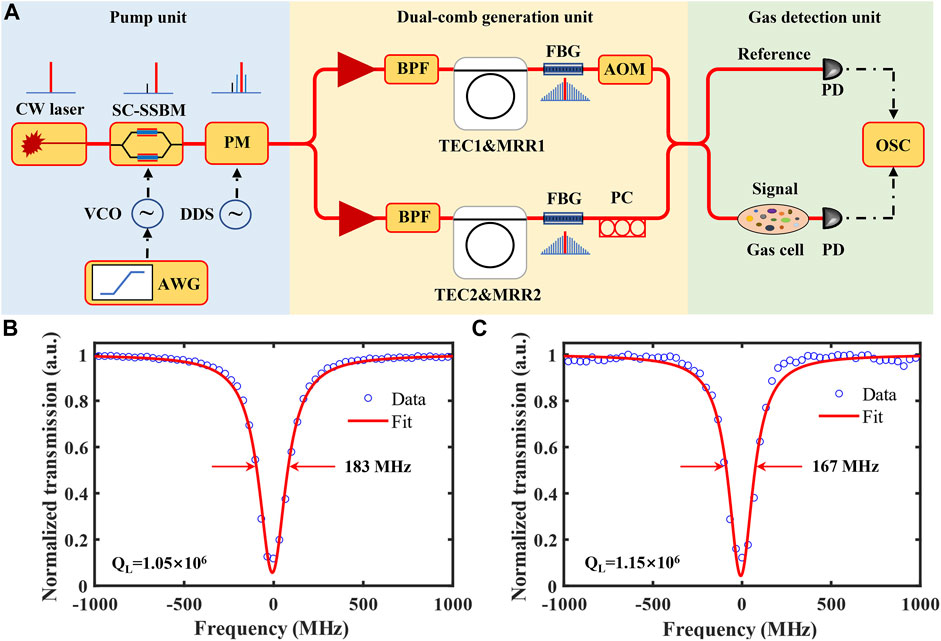
FIGURE 1. Experimental setup for dual-microcomb generation for spectroscopy. (A) Schematic of the experimental setup. SC-SSBM, suppressed-carrier single-sideband modulator; VCO, voltage-controlled oscillator; AWG, arbitrary waveform generator; PM, phase modulator; DDS, direct digital synthesis; BPF, band-pass filter; TEC, thermo-electric cooler; MRR, microring resonator; FBG, fiber Bragg grating; AOM, acousto-optic modulator; PC, polarization controller; PD, photodetector; OSC, oscilloscope; (B,C) are transmission spectra and Lorentzian fits for Q-factors measurements of two MRRs’ soliton modes, respectively.
Figures 1B,C show the transmission spectra of the two soliton modes in two MRRs. The full width at half maxima (FWHM) linewidths can be extracted by fitting with Lorentzian lineshapes, which are measured to be 183 and 167 MHz, corresponding to moderate loaded Q factors of 1.05 million and 1.15 million, respectively. To create a miniature and coherent dual-comb system, both microcombs are necessarily generated by a common pump laser, which means that the soliton modes of two MRRs need to be aligned to the pump mode. Therefore, thermo-electric coolers (TECs) were packaged beneath the MRRs for coarsely tuning the resonance wavelength with a resolution of 0.01°C according to the thermo-optic effect. Figure 2A shows the mode transmission spectra of MRR1 and MRR2 at low pump power and different temperatures. The temperature of MRR2 is firstly set to be 18.30°C to match the soliton mode with the pump laser wavelength. Next, the effective control of the soliton mode variation of MRR1 is shown by tuning the TEC temperature. As the temperature is increased from 15 to 45°C, a resonance wavelength red-shift can be observed from 1549.33 nm to 1550.01 nm. Figure 2B depicts the relation between the chip temperature and the resonance wavelength, with a linear fitting slope
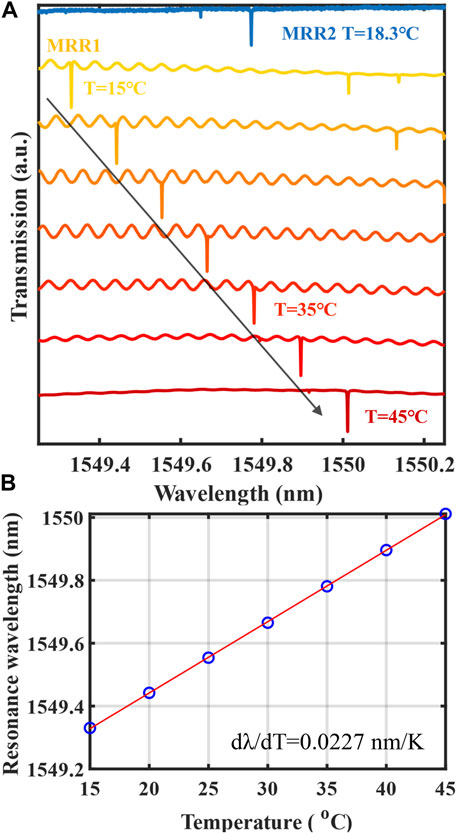
FIGURE 2. (A) Transmission of the two different soliton modes at low power and different temperatures. (B) Dependence of the resonance wavelength on the chip temperature and a linear fit.
As for the dual-microcomb generation, the method by combining the rapid frequency sweep with the sideband thermal compensation [45] is adopted. Compared to the auxiliary laser heating and integrated thermal tuning methods, this method shows a relatively simple system and a lower requirement on the Q values, respectively, by overcoming the thermal effect of the cavity and enlarging the “soliton existence range”. Here, the soliton existence range is defined as the frequency range that the pump laser can be swept without losing the soliton microcombs. To be specific, a rapid voltage ramp of 4–8 V through an arbitrary waveform generator (AWG) is applied to the voltage-controlled oscillator (VCO) driving the SSBM, corresponding to a rapid suppressed-carrier single-sideband frequency scanning of approximately 2.08 GHz within 75 ns from short to long wavelength. This rapid scanning speed of 27.25 GHz/μs, close to the thermo-optic response time of Si3N4 microresonators, could satisfy the equilibrium condition of the single-soliton microcomb generation. Then, an RF signal from the direct digital synthesis (DDS) with power and frequency of 6 dBm and 1000 MHz, respectively, is modulated on the phase modulator (PM) to generate an effective blue-shifted optical sideband, which plays a vital role in the cavity thermal compensation effect. As shown in Ref. [45], firstly, it could increase the “soliton existence range” from more than one hundred MHz to several GHz and reduce the pump power requirement. Secondly, the blue-shifted sideband is located in the thermal self-lock region, and could improve the soliton microcomb existence time from 1 h to beyond 12 h. Third, the sideband thermal compensation could effectively counteract thermo-refractive noise and achieve enhanced repetition rate stability and a decrease in the effective linewidth of the microcomb lines, which is also important for dual-microcomb performance.
On-chip pump powers of about 688 mW (MRR1) and 800 mW (MRR2) are needed for dual-microcomb generation. Then at the MRRs’ output, two microcombs are then sent to two fiber-Bragg gratings (FBGs) to exclude the strong pump for soliton outputs and monitoring. The calculated soliton conversion efficiencies are about 0.65 and 0.58%, respectively. Figure 3A illustrates the microcomb soliton powers evolution process when the control signal to scan the pump laser wavelength is applied. The soliton steps confirm that the microcombs go through the chaotic state and finally stay in the single-soliton state. There is a drift between the control signal and the detected onset of chaos/soliton dynamics, which could be possibly ascribed to the delayed response of the VCO. Figure 3B shows the generated dual single-soliton microcombs spectra spanning over 200 nm (25 THz). The spectra are well fitted by the sech2 function and the 3 dB bandwidth of the spectrum is around 40.5 nm, corresponding to a Fourier-transform-limited pulse duration of 62 fs.
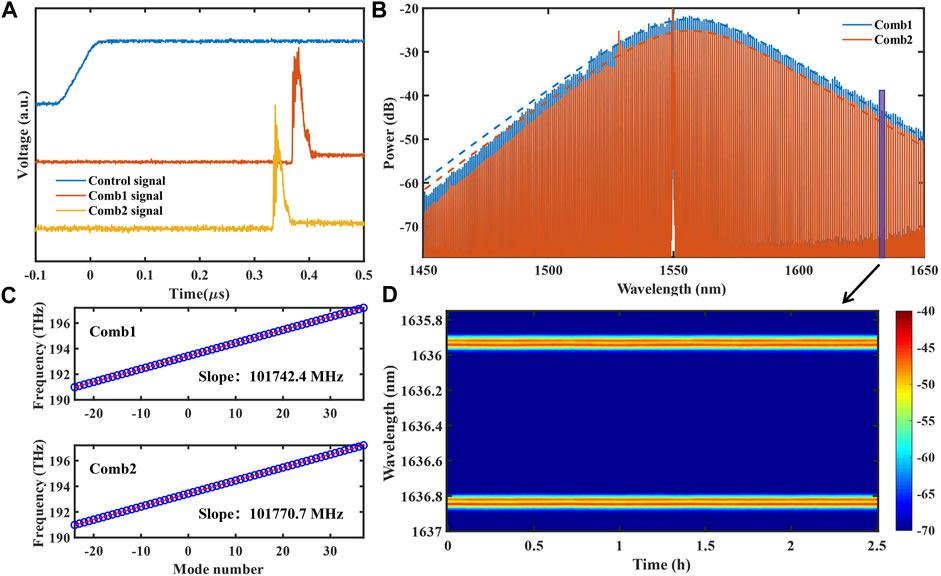
FIGURE 3. Soliton dual-microcomb generation and characterization. (A) Observed soliton steps versus scan time in the OSC. The blue curve represents the control signal of AWG to drive the VCO. The red and yellow curves show the power traces of the two soliton microcombs excluding the pump power. (B) Generated two single-soliton mode-locked microcomb optical spectra. Two fitted sech2 envelopes are also indicated by the blue and red dotted lines. (C) Characterization of two comb spacings over 60 comb lines and two linear fits. (D) Optical spectrum evolution color map beyond 2.5 h between 1635.8 nm and 1637 nm. The color bar reflects the power amplitude in the unit of decibel-milliwatts (dBm).
Due to the thermal compensation effect [46], the modulated blue detuned pump sideband can stay in the thermal self-lock region and help mitigate the resonance frequency shift caused by the environmental thermal variation. Therefore, the dual-microcomb could stably stay for several hours with no active locking technique used in experiments. Figure 3D shows the optical spectrum evolution map over 2.5 h between 1635.8 nm and 1637 nm. The spectra range is selected because the small repetition difference of tens of MHz cannot be directly distinguished at the spectrum center location with the spectrometer resolution of 0.02 nm. The comb line spacing determines the resolution of the dual-microcomb spectroscopy and the repetition rate difference is relevant to the spectroscopy acquisition speed. The repetition rate measurements are conducted by linear fitting the spectrum data obtained from the high precision spectrometer with a resolution of 0.04 p.m. As shown in Figure 3C, the two fits give estimations of the microcomb line spacings of 101.7424 and 101.7707 GHz for Comb1 and Comb2, respectively. Therefore, the repetition rate difference is obtained to be about 28.3 MHz, which indicates that a series of down-converting RF lines will arrange at this interval in DCS detection.
In order to have a better understanding of the repetition rate difference performance, the first red-detuned pair (around 1550.68 nm) of the comb teeth with respect to the pump is filtered out and detected by a PD. It is found that the repetition rate difference has a variation of approximately 1 MHz centered at 28 MHz at different pump powers. As demonstrated in Ref. [45], the modulated sideband plays a significant role in thermal compensation, which can effectively counteract thermo-refractive noise and achieve enhanced repetition rate stability. Hence, a better repetition rate difference beat note stability of the dual-microcomb is also predictable. For demonstration, the repetition rate difference characterization is compared with two different RF modulation powers of 0 dBm and 6 dBm, respectively in Figure 4. The dual-microcomb with RF power of 0 dBm is acquired by slowly tuning the pump laser wavelength while reducing the RF power from 6 dBm to 0 dBm. Unfortunately, one of the dual-microcomb collapses due to the decreased “soliton existence range” when the RF power is further decreased, though it can be realized in the single microcomb system. Therefore, a complete free-running dual-comb without the modulated sideband is not realized. The dual-microcomb with the 0-dBm modulation signal also has a shorter soliton existence time of about only several minutes, which is far less than that with modulation signal power of 6 dBm. Moreover, when the RF modulation power is increased beyond 6 dBm, the sideband power would exceed the parametric oscillation threshold (measured about 70 mW) and hinder the single soliton generation.
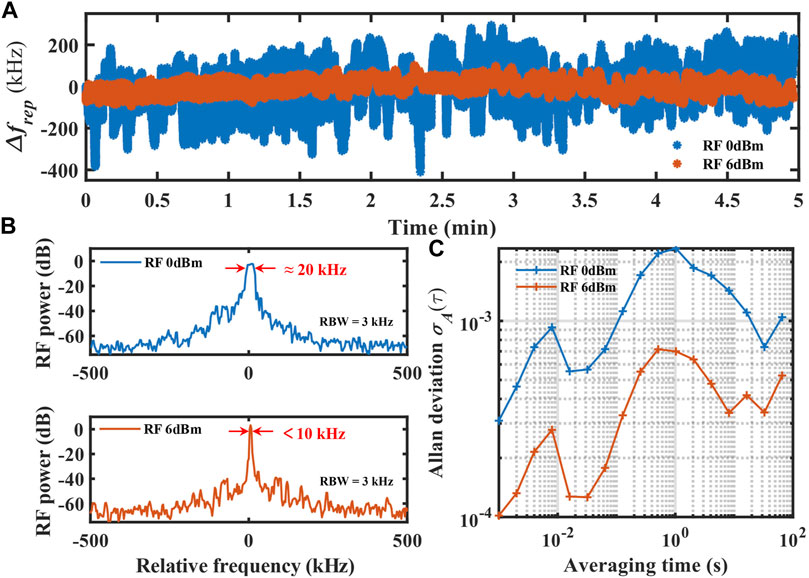
FIGURE 4. Repetition rate difference characterization of free-running dual-microcomb with different sideband modulation powers of 0 dBm (blue dots and lines) and 6 dBm (red dots and lines), respectively. (A) Repetition rate difference frequency counting measurement within 5 min at 1 ms gate time. (B) Repetition rate difference beat notes measured by the RF spectrum analyzer. The sweep time is set as 33.8 ms within a sweep range of 1 MHz with a resolution bandwidth (RBW) of 3 kHz. (C) Allan deviations of the repetition rate difference signal.
Figure 4A shows the measurements of the repetition rate difference drift within 5 min through a frequency counter at 1 ms gate time. The blue points represent the signal of the weakly modulated sideband, which has a jittering scope of about 700 kHz and a standard deviation (SD) of 107 kHz. The dual-microcomb with a higher modulated sideband power has a much less frequency drifting range of about 200 kHz and a SD of 35.4 kHz. Allan deviations have also been calculated in Figure 4C, which are subject to the environment temperature fluctuation and pump laser frequency drift in the free-running system. The instability is 3.1 × 10−4 at 1 ms for the dual-microcomb with lower RF modulation power, while there is a threefold decrease (1.0 × 10−4 at 1 ms) by injecting stronger sideband power due to the enhanced microcomb repetition rate stability, which is close to the stability in the Ref. [47]. It is also found that the Allan deviations would have a declining trend beyond 1 s integration time, which may be caused by the thermal compensation effect that reduces the long-time relative drift between the dual-microcomb.
The soliton mode-locked dual-microcomb has repetition rate difference beat notes with 3-dB linewidths of about 20 kHz and less than 10 kHz for RF modulation signals of 0 dBm and 6 dBm, respectively (Figure 4B). The stronger sideband power with narrower beat note (<10 kHz) guarantees a longer relative coherence time (
Next, a simple demonstration for the dual-microcomb spectroscopy application is conducted in experiments. Owing that the dual-microcomb shares the same pump laser, the down-converted RF spectrum of the left and right wings of the optical spectrum would be mixed up and cannot be distinguished. Therefore, as shown in Figure 1A, one of the microcombs at the dual-comb generation unit is sent to an acousto-optic modulator (AOM) to shift the spectrum of Comb1 with the
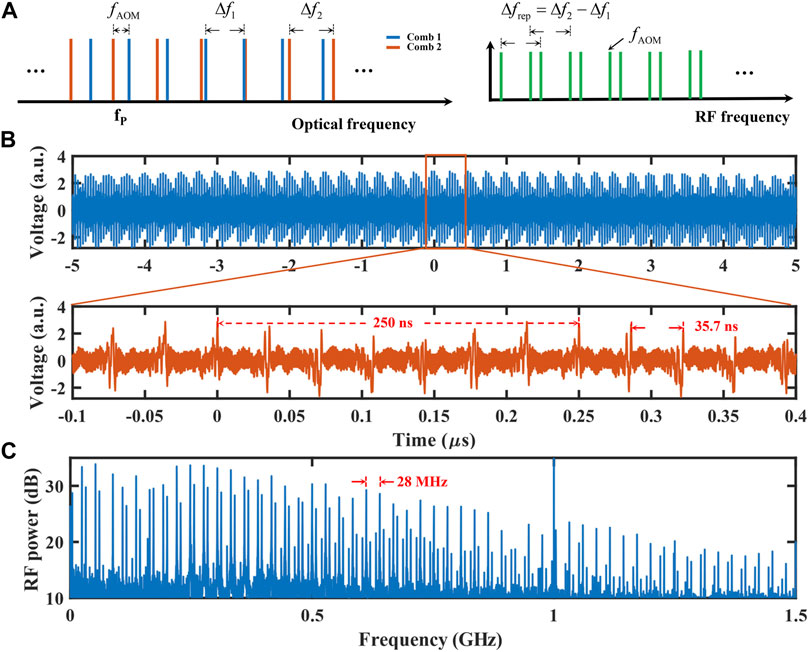
FIGURE 5. Experimental interferogram sequence and RF spectrum. (A) Schematic for dual-microcomb spectrum in optical domain and RF domain.
After combining the dual-microcomb with a fiber bidirectional coupler, one output passes through the test sample (gas cell) to serve as a signal output and the other acts as a reference output. Both outputs are synchronously detected with photodetectors and a fast real-time OSC to generate two interferograms of the two soliton pulse trains. Figure 5B shows an interferogram of the signal path within 10 μs at 5 gigasamples/s due to the maximum record length limitation of the OSC, though it is smaller than the maximum coherence time (>100 µs) of the dual-microcomb. The lower panel displays a zoomed-in time-domain interferogram result from −0.1 to 0.4 µs. The small period waveform repeats every 35.7 ns, corresponding to the inverse of the difference frequency (28 MHz) in the dual-microcomb repetition rates. It should also be emphasized that the maximum period lasts for 250 ns, corresponding to the inverse of the RF signal of 4 MHz from the beat note of the third pair of the dual-microcomb on the shorter wavelength. This maximum period also represents that the dual-microcomb system has a short single-shot acquisition time.
The time-domain interferogram is then Fourier-transformed to produce a comb-like RF electrical spectrum in Figure 5C. The beat-note signals of the two sides of the dual-microcomb spectrum are unaligned around the center frequency of
The dual-microcomb source has a short single spectrum acquisition time of about 250 ns at the expense of coarse resolution (101.8 GHz), which is suitable for liquids or solids detection with broad absorption features. However, limited by the experimental conditions, only a simple proof-of-principle gas absorption spectroscopy detection as an alternative in Figure 6A is performed. The gas cell used here has a mixture of H12CN, 12CO and 13CO, and the pressures of the gases inside the cell are 10 Torr (H12CN), 300 Torr (12CO) and 300 Torr (13CO), respectively. The blue lines represent the reference absorption spectrum obtained by conducting a wavelength scanning from 1522 nm to 1569 nm with an external cavity diode laser (ECDL). The output from the ECDL is split into three paths. One is coupled into the gas cell, another is used for monitoring the power fluctuation, and the last one is injected into the fiber ring with FSR at about 34 MHz for accurate wavelength calibration. The red lines are the results of the dual-microcomb spectroscopy, which is extracted by normalizing the signal spectrum by the reference spectrum. Here, only 10 μs time-domain signals are processed without any complex coherent averaging on multiple spectra, thus indicating the real-time nature of the dual-microcomb acquisition system.
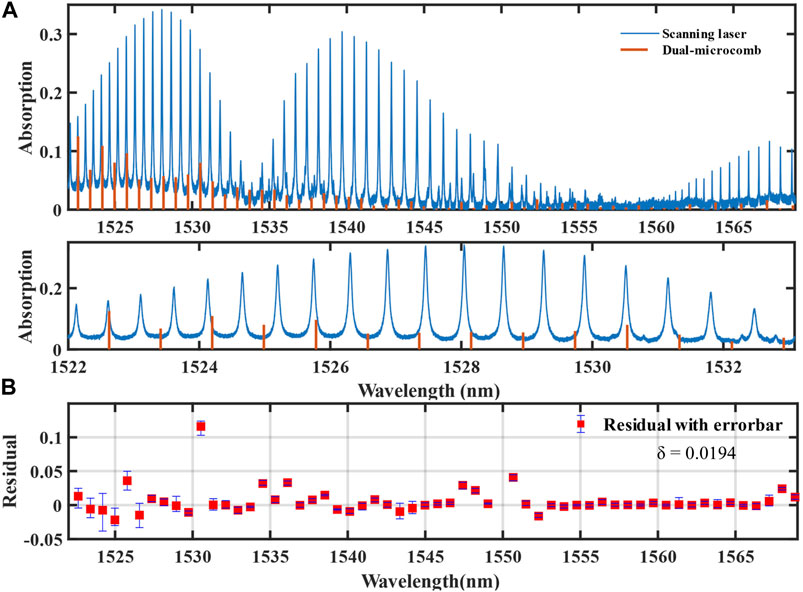
FIGURE 6. Gas absorption spectra test. (A) The gas absorption spectra measured by the wavelength-calibrated scanning laser and dual-microcomb. The absorption is defined as 1—T, with T the transmittance of the gas cell. The lower panel represents the spectra range between 1522 nm and 1533 nm. (B) The residual difference with errorbar between the two spectra.
Then the results of both absorption spectra on the upper panel in Figure 6A are compared. Owing that the coarse resolution of the dual-microcomb system (∼101.8 GHz) is much larger than the gas absorption linewidth of ∼21 GHz, the absorption of 12CO in the longer wavelength cannot be distinguished and only several absorption lines of H12CN on the shorter wavelength are coincidently detected. Other microcomb lines that miss the absorption lines can also measure the baseline absorption variations well. Furthermore, the line-by-line overlay of the wavelength-calibrated scanning laser spectrum and dual-comb spectrum on the lower panel in Figure 6A shows a clearer comparation of absorption intensity for H12CN from 1522 nm to 1533 nm. Most of the microcomb lines have a close strength compared to the reference except for some large deviations of individual microcomb lines, which are primarily limited by the short measurement time and low SNR in the wings of dual-microcomb spectrum. Moreover, the extra unwanted RF lines caused by the 1 GHz modulation signals would further reduce the overall SNR. After averaging several time-domain results, the residual difference with errorbar between the two absorption spectra is shown in Figure 6B and the calculated SD is 0.0194, which is comparable with that in Ref. [35]. It is believed that coherent averaging over abundant acquisitions can reduce the deviations, but at the cost of a longer acquisition time. Supplementary Table S1 provides a comparison of dual-microcomb parameters between our work and previous references.
In conclusion, a stable dual-microcomb generation method by utilizing the sideband thermal compensation effect has been demonstrated with two Si3N4 microresonators. Narrower repetition rate difference beat notes (<10 kHz) and smaller Allan deviations (1.0 × 10–4 at 1 ms) are achieved. This system has no strict requirement for ultra-high Q microrings and shows great potential for miniaturization and integration with compact and portable compositions. Moreover, the repetition rate difference
The raw data supporting the conclusion of this article will be made available by the authors, without undue reservation.
KY and TJ conceived the idea. RM and ZY performed the experiments. RM and CZ conducted the data processing. RM, KY, and XC contributed to writing and editing the paper. All authors have approved the final version of the manuscript.
This work was supported by the National Key Research and Development Program of China (2020YFB2205804), National Natural Science Foundation of China (62075240), Science Fund for Distinguished Young Scholars of Hunan Province (2020JJ2036), and Postgraduate Scientific Research Innovation Project of Hunan Province (CX20210004).
The authors declare that the research was conducted in the absence of any commercial or financial relationships that could be construed as a potential conflict of interest.
All claims expressed in this article are solely those of the authors and do not necessarily represent those of their affiliated organizations, or those of the publisher, the editors and the reviewers. Any product that may be evaluated in this article, or claim that may be made by its manufacturer, is not guaranteed or endorsed by the publisher.
The Supplementary Material for this article can be found online at: https://www.frontiersin.org/articles/10.3389/fphy.2022.989047/full#supplementary-material
1. Diddams SA, Vahala K, Udem T. Optical frequency combs: Coherently uniting the electromagnetic spectrum. Science (2020) 369:eaay3676. doi:10.1126/science.aay3676
2. Zhang H, Chang B, Li Z, Liang Y, Qin C, Wang C, et al. Coherent optical frequency combs: From principles to applications. J Electron Sci Technology (2022) 20:100157. doi:10.1016/j.jnlest.2022.100157
3. Wang H, Han H, Zhang Z, Shao X, Zhu J, Wei Z. An yb-fiber frequency comb phase-locked to microwave standard and optical reference. Chin Phys B (2020) 29:030601. doi:10.1088/1674-1056/ab696d
4. Chen Z, Hansch TW, Picque N. Mid-infrared feed-forward dual-comb spectroscopy. Proc Natl Acad Sci U S A (2019) 116:3454–9. doi:10.1073/pnas.1819082116
5. Niu R, Wan S, Li J, Zhao R, Zou C, Guo G, et al. Fast spectroscopy based on a modulated soliton microcomb. IEEE Photon J (2021) 13:1–4. doi:10.1109/jphot.2021.3104934
6. Hall JL. Nobel lecture: Defining and measuring optical frequencies. Rev Mod Phys (2006) 78:1279–95. doi:10.1103/RevModPhys.78.1279
7. Shen Q, Guan J, Zeng T, Lu Q, Huang L, Cao Y, et al. Experimental simulation of time and frequency transfer via an optical satellite–ground link at 10-18 instability. Optica (2021) 8:471. doi:10.1364/optica.413114
8. Marin-Palomo P, Kemal JN, Karpov M, Kordts A, Pfeifle J, Pfeiffer MHP, et al. Microresonator-based solitons for massively parallel coherent optical communications. Nature (2017) 546:274–9. doi:10.1038/nature22387
9. Riemensberger J, Lukashchuk A, Karpov M, Weng W, Lucas E, Liu J, et al. Massively parallel coherent laser ranging using a soliton microcomb. Nature (2020) 581:164–70. doi:10.1038/s41586-020-2239-3
10. Mitchell T, Sun J, Reid DT. Dynamic measurements at up to 130-khz sampling rates using ti:Sapphire dual-comb distance metrology. Opt Express (2021) 29:42119. doi:10.1364/oe.433871
11. Papp SB, Beha K, Del’Haye P, Quinlan F, Lee H, Vahala KJ, et al. Microresonator frequency comb optical clock. Optica (2014) 1:10–4. doi:10.1364/optica.1.000010
12. Zhang P, Zhang Y, Li M, Rao B, Yan L, Chen F, et al. All polarization-maintaining er:Fiber-based optical frequency comb for frequency comparison of optical clocks. Chin Phys B (2022) 31:054210. doi:10.1088/1674-1056/ac40f6
13. Chang L, Liu S, Bowers JE. Integrated optical frequency comb technologies. Nat Photon (2022) 16:95–108. doi:10.1038/s41566-021-00945-1
14. Wang W, Wang L, Zhang W. Advances in soliton microcomb generation. Adv Photon (2020) 2:034001. doi:10.1117/1.Ap.2.3.034001
15. Ma J, Xiao L, Gu J, Li H, Cheng X, He G, et al. Visible kerr comb generation in a high-q silica microdisk resonator with a large wedge angle. Photon Res (2019) 7:573–8. doi:10.1364/prj.7.000573
16. Wan S, Niu R, Wang Z-Y, Peng J, Li M, Li J, et al. Frequency stabilization and tuning of breathing solitons in si3n4 microresonators. Photon Res (2020) 8:1342–9. doi:10.1364/prj.397619
17. Hu Y, Ding S, Qin Y, Gu J, Wan W, Xiao M, et al. Generation of optical frequency comb via giant optomechanical oscillation. Phys Rev Lett (2021) 127:134301. doi:10.1103/PhysRevLett.127.134301
18. Bai Y, Zhang M, Shi Q, Ding S, Qin Y, Xie Z, et al. Brillouin-kerr soliton frequency combs in an optical microresonator. Phys Rev Lett (2021) 126:063901. doi:10.1103/PhysRevLett.126.063901
19. Zhang Q, Liu B, Wen Q, Qin J, Geng Y, Zhou Q, et al. Low-noise amplification of dissipative kerr soliton microcomb lines via optical injection locking lasers. Chin Opt Lett (2021) 19:121401. doi:10.3788/col202119.121401
20. Wan S, Niu R, Peng J, Li J, Guo G, Zou C, et al. Fabrication of the high-q si3n4 microresonators for soliton microcombs. Chin Opt Lett (2022) 20:032201. doi:10.3788/col202220.032201
21. Weng H, Liu J, Afridi AA, Li J, Dai J, Ma X, et al. Directly accessing octave-spanning dissipative kerr soliton frequency combs in an aln microresonator. Photon Res (2021) 9:1351–7. doi:10.1364/prj.427567
22. Shu H, Chang L, Tao Y, Shen B, Xie W, Jin M, et al. Microcomb-driven silicon photonic systems. Nature (2022) 605:457–63. doi:10.1038/s41586-022-04579-3
23. Wang X, Xie P, Wang W, Wang Y, Lu Z, Wang L, et al. Program-controlled single soliton microcomb source. Photon Res (2020) 9:66–72. doi:10.1364/prj.408612
24. Yao L, Liu P, Chen H, Gong Q, Yang Q, Xiao Y. Soliton microwave oscillators using oversized billion q optical microresonators. Optica (2022) 9:561. doi:10.1364/optica.459130
25. Wen Q, Cui W, Geng Y, Zhou H, Qiu K. Precise control of micro-rod resonator free spectral range via iterative laser annealing. Chin Opt Lett (2021) 19:071903. doi:10.3788/col202119.071903
26. Coddington I, Newbury N, Swann W. Dual-comb spectroscopy. Optica (2016) 3:414–26. doi:10.1364/optica.3.000414
27. Picqué N, Hänsch TW. Frequency comb spectroscopy. Nat Photon (2019) 13:146–57. doi:10.1038/s41566-018-0347-5
28. Kara O, Maidment L, Gardiner T, Schunemann PG, Reid DT. Dual-comb spectroscopy in the spectral fingerprint region using opgap optical parametric oscillators. Opt Express (2017) 25:32713. doi:10.1364/oe.25.032713
29. Ideguchi T, Nakamura T, Kobayashi Y, Goda K. Kerr-lens mode-locked bidirectional dual-comb ring laser for broadband dual-comb spectroscopy. Optica (2016) 3:748. doi:10.1364/optica.3.000748
30. Liu H, Sun S, Zheng L, Wang G, Tian W, Zhang D, et al. Review of laser‐diode pumped ti:Sapphire laser. Microw Opt Technol Lett (2021) 63:2135–44. doi:10.1002/mop.32882
31. Chen Z, Yan M, Hansch TW, Picque N. A phase-stable dual-comb interferometer. Nat Commun (2018) 9:3035. doi:10.1038/s41467-018-05509-6
32. Guo H, Weng W, Liu J, Yang F, Hänsel W, Brès CS, et al. Nanophotonic supercontinuum-based mid-infrared dual-comb spectroscopy. Optica (2020) 7:1181. doi:10.1364/optica.396542
33. Yan Q, Li Y, Zhang J, Zheng X, Wu D, Yin K, et al. A free-running dual-comb spectrometer with intelligent temporal alignment algorithm. Opt Laser Technol (2021) 141:107175. doi:10.1016/j.optlastec.2021.107175
34. Durán V, EscobarVera C, SorianoAmat M, Martins HF, MartinLopez S, GonzalezHerraez M, et al. Dual electro-optic comb spectroscopy using a single pseudo-randomly driven modulator. Opt Express (2022) 30:25103. doi:10.1364/oe.463604
35. Suh M-G, Yang Q-F, Yang KY, Yi X, Vahala K. Microresonator soliton dual-comb spectroscopy. Science (2016) 354:600–3. doi:10.1126/science.aah6516
36. Yu M, Okawachi Y, Griffith AG, Picque N, Lipson M, Gaeta AL. Silicon-chip-based mid-infrared dual-comb spectroscopy. Nat Commun (2018) 9:1869. doi:10.1038/s41467-018-04350-1
37. Dutt A, Joshi C, Ji X, Cardenas J, Okawachi Y, Luke K, et al. On-chip dual-comb source for spectroscopy. Sci Adv (2018) 4:e1701858. doi:10.1126/sciadv.1701858
38. Bao C, Yuan Z, Wu L, Suh MG, Wang H, Lin Q, et al. Architecture for microcomb-based ghz-mid-infrared dual-comb spectroscopy. Nat Commun (2021) 12:6573. doi:10.1038/s41467-021-26958-6
39. Shams-Ansari A, Yu M, Chen Z, Reimer C, Zhang M, Picqué N, et al. Thin-film lithium-niobate electro-optic platform for spectrally tailored dual-comb spectroscopy. Commun Phys (2022) 5:88–8. doi:10.1038/s42005-022-00865-8
40. Geng Y, Zhou H, Han X, Cui W, Zhang Q, Liu B, et al. Coherent optical communications using coherence-cloned kerr soliton microcombs. Nat Commun (2022) 13:1070–8. doi:10.1038/s41467-022-28712-y
41. Wang Y, Wang Z, Wang X, Shao W, Huang L, Liang B, et al. Scanning dual-microcomb spectroscopy. Sci China Phys Mech Astron (2022) 65:294211–7. doi:10.1007/s11433-022-1920-6
42. Zhou H, Geng Y, Cui W, Huang SW, Zhou Q, Qiu K, et al. Soliton bursts and deterministic dissipative kerr soliton generation in auxiliary-assisted microcavities. Light Sci Appl (2019) 8:50–10. doi:10.1038/s41377-019-0161-y
43. Lin T, Dutt A, Joshi C, Ji X, Phare CT, Okawachi Y, et al. Broadband ultrahigh-resolution chip-scale scanning soliton dual-comb spectroscopy. arXiv preprint arXiv:00869 (2020).
44. Weng H, Afridi AA, Li J, McDermott M, Tu H, Barry LP, et al. Dual-mode microresonators as straightforward access to octave-spanning dissipative kerr solitons. APL Photon (2022) 7:066103. doi:10.1063/5.0089036
45. Miao R, Zhang C, Zheng X, Cheng X, Yin K, Jiang T. Repetition rate locked single-soliton microcomb generation via rapid frequency sweep and sideband thermal compensation. Photon Res (2022) 10:1859–67. doi:10.1364/prj.458472
46. Nishimoto K, Minoshima K, Yasui T, Kuse N. Thermal control of a kerr microresonator soliton comb via an optical sideband. Opt Lett (2022) 47:281–4. doi:10.1364/ol.448326
Keywords: kerr frequency combs, dual-microcomb, microresonators, soliton, absorption spectroscopy
Citation: Miao R, Yin K, Zhang C, Yu Z, Cheng X and Jiang T (2022) Stable soliton dual-microcomb generation via sideband thermal compensation for spectroscopy. Front. Phys. 10:989047. doi: 10.3389/fphy.2022.989047
Received: 08 July 2022; Accepted: 18 August 2022;
Published: 09 September 2022.
Edited by:
Hainian Han, Institute of Physics (CAS), ChinaReviewed by:
Marco Lamperti, University of Insubria, ItalyCopyright © 2022 Miao, Yin, Zhang, Yu, Cheng and Jiang. This is an open-access article distributed under the terms of the Creative Commons Attribution License (CC BY). The use, distribution or reproduction in other forums is permitted, provided the original author(s) and the copyright owner(s) are credited and that the original publication in this journal is cited, in accordance with accepted academic practice. No use, distribution or reproduction is permitted which does not comply with these terms.
*Correspondence: Ke Yin, Y3F5aW5rZUAxMjYuY29t; Tian Jiang, dGppYW5nQG51ZHQuZWR1LmNu
Disclaimer: All claims expressed in this article are solely those of the authors and do not necessarily represent those of their affiliated organizations, or those of the publisher, the editors and the reviewers. Any product that may be evaluated in this article or claim that may be made by its manufacturer is not guaranteed or endorsed by the publisher.
Research integrity at Frontiers

Learn more about the work of our research integrity team to safeguard the quality of each article we publish.